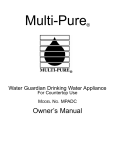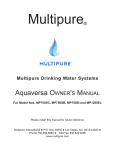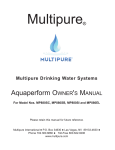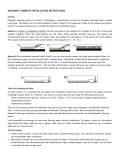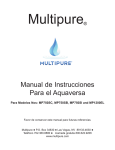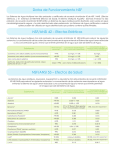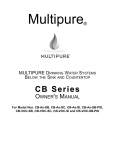Download Multi-Pure MPADC Owner`s manual
Transcript
Multipure ® Aquadome Drinking Water System For Countertop Use Only MODel NO. MPAD Owner’s Manual Please retain this manual for future reference. Multipure l P.O. Box 34630 l las Vegas, NV 89133-4630 Phone 702.360.8880 l Toll-Free 800.622.9206 www.multipure.com l [email protected] Multipure Drinking Water Systems Thank you for selecting a Multipure Drinking Water System to meet your need for quality drinking water. You have acquired one of the finest drinking water treatment devices available for the reduction of a wide array of contaminants. We are confident that your Multipure System will make a difference in your life. Thank you for your business. Table of Contents About 3 Before You Begin 3 Specifications 3 Installation Overview and Part Numbers 4 1. 2. Installation 1.1: Inspect Your Drinking Water System 1.2: Connect the Hose to the Housing 1.3: Connect the Hose and Diverter Valve to the Faucet 1.4: Disconnecting the Hose and Diverter Valve (when replacing hose) 1.5: Prepare Your Drinking Water System Operation 2.1: Operating Your Drinking Water System 4 5 5-6 6 6 6 3. Maintenance 3.1: Regarding Filter Capacity 7 3.2: Removing the Old Filter 7 3.3: Installing the New Filter 7 3.4: Drinking Water System Will Be Unused for More than 10 Days 8 3.5: Flushing / Disinfecting the System 8 4. Additional Information 4.1: Warranty 4.2: Performance Certifications 4.3: Performance Data Sheet 4.4: California Certification 4.5: Troubleshooting 4.6: Frequently Asked Questions 8 9 10-12 13 14 15 2 About the Aquadome Drinking Water System • • • The Multipure Aquadome Drinking Water System (Model# MPAD) is designed for use on the countertop next to the sink. It connects to the existing faucet with a diverter valve that allows free selection between filtered and unfiltered water. The Aquadome includes all the accessories and fittings required for installation. If installation or operation assistance is required, please contact your Multipure Independent Distributor. If the Independent Distributor is unavailable, please contact Multipure Customer Service at 1.800.622.9206. Before You Begin Multipure Drinking Water Systems (DWS) have been extensively tested and certified by NSF International to provide the highest level of assurance that the device will perform as claimed. Please read this manual before proceeding with the installation and use of your system. Installation, operation, and maintenance requirements are essential to the performance of your system – failure to follow any instructions or operating parameters contained herein may lead to product damage or product failure. • • • • • • • Replacement filters can be purchased directly from Multipure. For the latest prices, please visit our website at http://www.multipure.com/store/. Actual filter life depends on the amount of water used and the level of impurities in the water. See 3.1: Regarding Filter Capacity for additional details. Multipure Drinking Water Systems are not intended for use with microbiologically unsafe water or non-municipally-treated water. Systems certified for cyst reduction may be used on disinfected waters that may contain filterable cysts. See 4.6: Frequently Asked Questions for additional details. Do not allow water to freeze in the system. If the system is exposed to freezing temperatures, drain water from the system and remove the filter. Allow the filter to thaw before replacing and reusing. Do not allow water to sit in the system for extended periods of time (e.g., 10 days or more) without use. See 3.4: If Your Drinking Water System Will Be Unused for More than 10 Days for additional details. To dispose of the used filter, remove it from the housing and place in normal refuse. Filters disposed in a normal landfill will not release any chemical contaminants and may continue to adsorb additional contaminants in the landfill. Check for compliance with any state or local laws and regulations before use. Specifications 3 Installation Overview & Part Numbers Part Numbers 1 6 1. 2. 3. 4. 5. 6. 7. 2 3 800-50-3201 CB6AD MC357 800-51-3201 MC6500ASBl MC008 MC700 5 4 Housing Top Filter Cartridge Black Gasket Housing Bottom Hose and Diverter Valve Hand Tool 4 Standard Adapters* (shown on page 5) * Adapters are not included as part of the NSF Unit Certification. I. Installation 1.1: Inspect Your Drinking Water System NOTe: The filter cartridge is factory-installed inside the unit housing. The Aqua Dome unit is for countertop use only. 1. Inspect your DWS to confirm that it has been received in good condition and that all parts are included. 2. Determine a countertop location for system placement, factoring in distance to the faucet for diverter valve and hose connection. housing top 3. Inspect the system housing to confirm that the housing top and bottom are securely connected. a. b. With the system sitting upright, slide the hand tool over the top so that the ridges on the tool fit into the grooves on the housing top. While holding the system base in place, firmly turn the hand tool clockwise to tighten the housing top. hand tool housing base 4 1.2: Connect the Hose to the Housing NOTe: The Aqua Dome comes with a diverter valve and hose that connects the drinking water system to your faucet. 1. 2. 3. 4. On the diverter valve and hose, locate the two stems at the end of the hose opposite the diverter valve. Identify the large stem (Inlet Stem) and small stem (Outlet Stem). On the DWS, locate the two ports on the bottom rear of the system housing. Identify the lower, large port (Inlet Port) and upper, small port (Outlet Port). Insert the Inlet Stem into the Inlet Port by slowly pushing the stem straight into the port as far as possible. Confirm the connection by pushing the stem in again. Insert the Outlet Stem into the Outlet Port by slowly pushing the stem straight into the port as far as possible. Confirm the connection by pushing the stem in again. Small stem Outlet Inlet large stem 1.3: Connect the Hose and Diverter Valve to the Faucet 1. 2. Remove the aerator or screen (if present) from the end of the faucet. If facing the open end of the spout, rotate the aerator counter-clockwise to loosen and remove. Attach the diverter valve directly to the faucet spout. If the threads of the diverter valve do not match the threads of the faucet, use one of the included faucet adapters to connect the diverter valve and faucet. If facing the open end of the spout, rotate the diverter valve and/or adapter clockwise to tighten. NOTE: When using a faucet adapter, the rubber washer in the adapter always faces up toward the faucet. a. If Your Faucet Has an Outside Thread (male connector): For many faucets with an outside thread, the diverter valve can attach directly to the faucet. If the diverter valve is too small to attach to the faucet, attach the inside thread (female connector) adapter, part# MC106, to the faucet, and then attach the diverter valve to the adapter. b. If Your Faucet Has an Inside Thread (female connector): The diverter valve cannot directly connect to a faucet with a female connector. Attach one of the outside thread (male connector) adapters, part# MC107 or part# MC108, to the faucet, and then attach the diverter valve to the adapter. MC107 is designed to fit larger faucets, and MC108 is designed to fit smaller faucets. c. If Your Faucet Requires More Room for the Diverter Valve Connection: Some faucets, particularly sprayer hose faucets, require additional room for the diverter valve connection. If this applies, attach the long adapter, part# MC257, to the opening of the faucet spout/sprayer, and then attach the diverter valve to the adapter. The DWS may need to be repositioned on the sink to allow enough room for sprayer faucet use. d. If the Adapters Do Not Fit Your Faucet: Although the adapters included with your DWS allow connections with many standard faucets, they do not cover every type of available faucet connection. If none of the adapters allow the diverter valve to connect to your faucet, please contact Multipure Customer Service at 1.800.622.9206, ext. 175, to request either part# MC109 or part# MC719 as possible adapter solutions. existing Faucet *MC106 *MC107 Swivel Bypass lever Attachment Ring *MC108 Hose *MC257 Diverter Valve Diverter Valve Attachment Diverter Valve Attachment with adapter * Adapters are not included as part of the NSF Unit Certification. 5 *MC700 - Adapters (choose one) Many installations do not require an adapter 1.3: Connect the Hose and Diverter Valve to the Faucet (continued) 3. When connected properly, the hose from the diverter valve should lead toward the back of the faucet and sink. 4. The diverter valve features a bypass lever with a button on the left and right sides of the diverter valve. Press the left button to bypass the DWS and select the unfiltered water spout (larger opening). Turn on your faucet to let unfiltered water flow out of the diverter valve and to make sure that the diverter valve is properly connected. 5. Turn off the faucet. 1.4: Disconnecting the Hose and Diverter Valve (when replacing hose) Follow these instructions when you are replacing the hose and diverter valve. NOTE: Do not forcefully pull the connectors out, this will cause damage to the housing base. Ensure the system is depressurized before removing fittings. 1. To disconnect the hose, you will need to release the small and large stem from the housing base (see Fig. A). a. Push in the collet against the tube stop (center of the fitting). With the collet held in this position the tubing/stem can be removed. Repeat for both tubes. 2. Remove tubing Fig. A Proceed with installing new hose to the housing (on previous page). 1.5: Prepare Your Drinking Water System 1. 2. 3. Using a paper towel or cloth, dry off all connections and the DWS housing. Make sure that all connections are tightly secured. Purge any air from the unit. a. Turn the DWS housing upside down, and then turn on the faucet. b. Press the right button on the diverter valve to select the filtered water spout. The water will flow through the DWS and emerge from the smaller opening on the diverter valve. c. Allow water to flow through the DWS and filtered water spout for one minute. d. Press the left button to select the unfiltered water spout, and then turn off the faucet. 4. Turn the DWS right side up and place it on the counter. 5. Make sure that all connections are tightly secured and that there are no leaks. 6. Turn on the faucet and press the right button to selected the filtered water spout. 7. Allow water to flow through the DWS and filtered water spout for approximately 30 minutes. This will flush the filter and charge the carbon. 8. Press the left button to select the unfiltered water spout. 9. Turn off the faucet. 10. Check all connections to make sure that there are no leaks. bypass lever unfiltered water filtered water aerator 2. Operation 2.1: Operating Your Drinking Water System 1. For unfiltered water, press the left button on the diverter valve. Water from the faucet will emerge from the unfiltered water spout. 2. For filtered water, press the right button on the diverter valve. Water from the faucet will flow through the DWS before emerging from the filtered water spout. If you have any questions regarding the installation of your countertop unit, call Multipure: Customer Service Department 7251 Cathedral Rock Drive, Las Vegas, NV 89128 702.360.8880 phone * 800.622.9206 toll-free * 702.360.8575 fax email: [email protected] * www.multipure.com 6 3. Maintenance 3.1: Regarding Filter Capacity 1. exact filter capacity varies in proportion to the amount of water used and the level of impurities in the water being processed. For contaminants reduced through physiochemical adsorption, the filter capacity is 750 gallons. For contaminants reduced through mechanical filtration, capacity claims are inapplicable due to broad variations in the quality and quantity of physical matter in the drinking water. excessive physical matter will cause the DWS to clog, diminishing flow rate but reducing the contaminants from the resultant water stream. 2. For optimum performance and to maintain the lifetime warranty on your system housing, it is essential that the filter be replaced when the first of the following occurs: a. annually, b. when the system reaches its rated capacity, c. when the flow rate diminishes, or d. when the filter becomes saturated with bad tastes and/or odors. 3.2: Removing the Old Filter 1. Before opening the DWS housing, place the system either on a folded towel, in a basin or other container, or in the sink. 2. With the faucet off, press the right button on the diverter valve to select the filtered water spout and flush water out of the DWS. 3. When the flow of water stops, press the left button on the diverter valve to stop the filtered water spout. 4. With the system sitting upright, slide the hand tool over the top so that the ridges on the tool fit into the grooves on the housing top. 5. Holding the base steady, use the hand tool to turn the DWS counterclockwise to loosen. 6. Once the top is loose, you can complete rotating it counter-clockwise by hand. 7. Once unscrewed, lift the housing top off of the base, leaving the black gasket on the bottom of the base. 8. Remove the old filter cartridge from the base by pulling it upward and slightly twisting until it is released from the base. 9. Dispose of the old filter in your waste container. 10. Rinse out the inside of the system housing, hand washing if necessary. bypass lever 3.3: Installing the New Filter 1. If you have not done so already, remove the plastic wrapper and instruction wrap from around the new filter. 2. Insert the new filter in the center port of the housing base, twisting slightly. Push straight down on the filter to ensure that it is firmly in place. 3. Place the housing top over the filter and back onto the base. Turn it clockwise to tighten. 4. If necessary, use the hand tool to further tighten the housing top to the base, turning it clockwise while holding the base steady. 5. Proceed to 1.5: Preparing Your Drinking Water System to complete the installation. 7 Flush without filtered water aerator 3.4: If Your Drinking Water System Will Be Unused for More than 10 Days To prevent the water sitting in the system from stagnating and becoming contaminated, flush the system and remove the filter if it will be unused for more than 10 days. 1. With the faucet off, press the right button on the diverter valve to select the filtered water spout and allow water to flow out of the DWS. 2. When the water flow stops, press the left button on the diverter valve. 3. Unscrew the housing top from the DWS by rotating it counter-clockwise. 4. With the housing top removed, pull out the filter cartridge and set it on a cloth or paper towel to dry. 5. Pour out any remaining water from the bottom half of the system housing. 6. Reconnect the top half of the system housing by rotating it clockwise. 7. To resume normal use of the DWS, proceed to 1.5 Prepare Your Drinking Water System. 3.5: Flushing / Disinfecting the System If your DWS is left unused for more than 10 days with the filter and water inside, the stagnant water and system may become contaminated. Before it can be reused, the system must be flushed and disinfected, and the filter must be replaced. 1. With the faucet off, press the right button on the diverter valve to select the filtered water spout and allow water to flow out of the DWS. 2. When the flow of water stops, press the left button on the diverter valve. 3. Unscrew the housing top from the DWS by rotating it counter-clockwise. 4. With the housing top removed, pull out the filter cartridge and dispose of it in your refuse. 5. Clean and rinse out the inside of the system housing. 6. Add 5 to 7 drops of bleach to the bottom half of the housing. 7. Reconnect the top half of the housing without a replacement filter installed. 8. Turn the DWS housing upside down, and then turn on the faucet. 9. Press the right button on the diverter valve to select the filtered water spout and allow the water and bleach to fill up the DWS. 10. Once water begins to flow, press the left button to stop the filtered water spout. 11. Turn off the faucet. 12. Turn the DWS housing right side up and let the unit soak for at least 30 minutes. 13. After 30 minutes, with the faucet off, press the right button on the diverter valve to select the filtered water spout and flush the water and bleach out of the system. 14. When the flow of water stops, open, clean, and rinse out the inside of the system housing. 15. Proceed to 3.3: Installing the New Filter to install the new filter and initialize the system. 4. Additional Information 4.1: Warranty • • Multipure 90-Day Guarantee: Multipure is confident in the performance of its Drinking Water Systems (DWS). If you should find this Drinking Water System unsatisfactory, let us know within 90 days of purchase for a prompt exchange or refund. Multipure Warranty: Multipure Corporation warrants to the original retail customer its DWS and components to be free of defects in material and workmanship for use under normal care, and will repair or replace any system at no charge (excluding transportation to Multipure Corporate Headquarters) to the customer during the warranty period. The DWS housing is warranted for a lifetime (provided the filter has been changed at least once per year); all exterior hoses and attachments to the DWS are also warranted for defects in material and workmanship for one (1) year. Multipure Solid Carbon Block Filters are warranted for defects in material and workmanship for use under normal care. The capacity of the filter cartridge depends upon the amount of impurities in the water to be processed. except as otherwise expressly provided above, Multipure Corporation makes no warranties, express or implied, arising by law or otherwise, including without limitation the implied warranties of merchantability and fitness for a particular purpose, to any person. This limited warranted may not be altered, varied, or extended except by a written instrument executed by Multipure Corporation. The remedy of repair or replacement as provided under this limited warranty is exclusive. In no event shall Multipure Corporation be liable for any consequential or incidental damages to any person whether occasioned by negligence of the manufacturer, including without limitation damages of loss of use, cost of substitution, property damage, or other monetary loss. Warranty is valid only if the DWS is operated within conditions listed herein. The warranty begins from the date of purchase 8 4.2: Performance Certifications Multipure Drinking Water Systems Product Performance Tested and Certified Multipure Drinking Water Systems have been tested and certified by NSF International to comply with NSF/ANSI Standards 42 and 53 for the reduction of specific contaminants being considered as established or potential health hazards. Standard 42, Aesthetic Effects Standard 53, Health Effects System tested and certified by NSF International against NSF/ANSI Standard 42 for the reduction of: Chloramine Chlorine taste and odor Nominal Particulate reduction, class I System tested and certified by NSF International against NSF/ANSI Standard 53 for the reduction of: Asbestos Chlordane Cyst lead Mercury MTBe PCB Toxaphene Turbidity Radon VOC (listed below) Standard 401, Emerging Contaminants Claims of capacity are not applicable to contaminants reduced by mechanical filtration because of broad variations in the quality and quantity of physical matter in your drinking water. System tested and certified by NSF International against NSF/ANSI Standard 401 for the reduction of: Atenolol Carbamazepine DeeT linuron Meprobamate Metolachlor Trimethoprim TCeP TCPP Bisphenol A estrone Ibuprofen Naproxen Nonyl phenol Phenytoin Filter Model CB6AD Volatile Organic Chemicals (VOC) includes: Disinfection By-Products chloropicrin haloacetonitriles (HAN): bromochloroacetonitrile dibromoacetonitrile dichloroacetonitrile trichloroacetonitrile haloketones (HK): 1,1-dichloro-2-Propanone 1,1-trichloro-2-Propanone trihalomethanes (THMs; TTHMs): bromodichloromethane bromoform chloroform dibromochloromethane tribromoacetic acid Chemicals benzene carbon tetrachloride chlorobenzene 1,2-dichloroethane 1,1-dichloroethylene cis-1,2-dichloroethylene 1,2-dichloropropane cis-1,3-dichloropropylene ethylbenzene hexachlorobutadiene hexachlorocyclopentadiene simazine styrene 1,1,2,2-tetrachloroethane tetrachloroethylene toluene trans-1,2-dichloroethylene 1,2,4-trichlorobenzene 1,1,1-trichloroethane 1,1,2-trichloroethane trichloroethylene xylenes (total) 9 Herbicides alachlor atrazine 2,4-D dinoseb pentachlorophenol 2,4,5-TP (silvex) Pesticides carbofuran dibromochloropropane (DBCP) o-dichlorobenzene p-dichlorobenzene endrin ethylene dibromide (eDB) heptachlor heptachlor epoxide lindane methoxychlor 4.3: Performance D a t e S h e e t Performance Data Sheet Multipure Drinking Water Systems have been tested and certified under NSF/ANSI Standard Nos. 53 as shown below. The concentration of the indicated substances in water entering the system was reduced to a concentration less than or equal to the permissible limit for water leaving the system, as specified in NSF/ANSI 53, Health effects. For Model No. MPAD **Percent reduction reflects actual performance of Multipure product as specifically tested (at 200% of capacity, i.e. 1500 gallons). Percent reduction shown for VOCs* reflects the allowable claims for Volatile Organic Chemicals/Compounds as per Tables. Chloroform was used as a surrogate for VOC reduction claims: the Multipure Systems’ actual reduction rate of Chloroform was >99.8% as tested (at 200% of capacity). 10 4.3: Performance Data Sheet (continued) 11 4.3: Performance Data Sheet (continued) NSF/ANSI 42 - Aesthetic Effects The System has been tested according to NSF/ANSI Standard 42 for the reduction of the following substances. The concentration of the indicated substances in water entering the system was reduced to a concentration less than or equal to the permissible limit for water leaving the system. Note: This addresses the U.S. environmental Protection Agency (ePA) Primary and Secondary Drinking Water Regulations in effect at its time of publication, they relate to Multipure’s performance in conformance to the industry performance criteria. These regulations are continually being updated at the Federal level. Accordingly, this list of MCls will be reviewed and amended when appropriate. Please see sales brochure for list of product certifications. NSF/ANSI 401 - Emerging Contamiants This system has been tested according to NSF/ANSI 401 for reduction of the substances listed below. The concentration of the indicated substances in water entering the system was reduced to a concentration less than or equal to the permissible limit for water leaving the system, as specified in the NSF/ANSI 401. 12 NOTES: 1. Multipure Drinking Water Systems have been certified, as indicated, by NSF International for compliance to NSF/ANSI Standard Nos. 42, 53 & 401. 2. The Multipure Drinking Water Systems have been certified by the State of California Department of Public Health for the reduction of specific contaminants listed herein. 3. Chloroform was used as a surrogate for claims of reduction of VOCs. Multipure Systems tested at >99.8% actual reduction of Chloroform. Percent reduction shown herein reflects the allowable claims for VOCs as per tables in the Standard. 4. Do not use with water that is microbiologically unsafe or of unknown quality without adequate disinfection before or after the system. Systems certified for cyst reduction may be used on disinfected water that may contain filterable cysts. 5. Filter life will vary in proportion to the amount of water used and the level of impurities in the water being processed. For optimum performance, it is essential that the filter be replaced on a regularly scheduled basis as follows: (a) annually; (b) when the unit’s rated capacity has been reached; (c) the flow rate diminishes; or (d) the filter becomes saturated with bad tastes and odors. 6. Multipure Drinking Water System Housings are warranted for a lifetime (provided that filter has been changed at least once per year). All exterior hoses and attachments to the System are warranted for one year. Please see the Owner’s Manual for complete product guarantee and warranty information. 7. Please see the Owner’s Manual for installation instructions and operating procedures. 8. In compliance with New York law, it is recommended that before purchasing a water treatment system, NY residents have their water supply tested to determine their actual water treatment needs. Please compare the capabilities of the Multipure unit with your actual water treatment needs. 9. While testing was performed under standard laboratory conditions, actual performance may vary. 10. The list of substances which the treatment device reduces does not necessarily mean that these substances are present in your tap water. 4.4: California Certification Department of Public Health State of California Department of Public Health Water Treatment Device Certificate Number 05 - 1736 Date Issued: October 20, 2010 Trademark/Model Designation Multi-Pure MPAD Replacement Elements CB6AD Multi-Pure MPADC CBTAD Manufacturer: Multi-Pure Drinking Water Systems The water treatment device(s) listed on this certificate have met the testing requirements pursuant to Section 116830 of the Health and Safety Code for the following health related contaminants: Microbiological Contaminants and Turbidity Cysts Turbidity Inorganic/Radiological Contaminants Asbestos Lead Mercury Organic Contaminants Chlordane MTBE PCB Toxaphene VOCs Rated Service Capacity: 750 gals Rated Service Flow: 0.75 gpm Conditions of Certification: Do not use where water is microbiologically unsafe or with water of unknown quality, except that systems certified for cyst reduction may be used on disinfected waters that may contain filterable cysts. 13 4.5: Tr o u b l e s h o o t i n g 14 4.6: Frequently Asked Questions 15 For instructions in Spanish, please see Spanish Manual Be sure to replace your filter at least once a year or sooner, if needed. Date of Installation:________________________________________ Fecha de Instalación Unit Model Number:_______________________________________ Tipo de Unidad Filter Type:______________________________________________ Tipo de Filtro Dates of Filter Change / Fechas de Cambio del Filtro To order a Replacement Filter Call 800.622.9208 or www.multipure.com/rf.html Multipure las Vegas Technology Center 7251 Cathedral Rock Drive las Vegas, NV 89128 800.622.9206 email: [email protected] www.multipure.com F508AD/1502


















